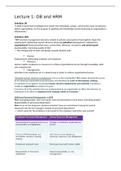Lecture 1: OB and HRM
Definition OB
“A field of study that investigates the impact that individuals, groups, and structure have on behavior
within organizations, for the purpose of applying such knowledge toward improving an organization’s
effectiveness.”
Definition HRM
"HRM involves management decisions related to policies and practices that together shape the
employment relationship and are aimed at achieving individual (development, satisfaction),
organizational (financial performance, productivity, efficiency, inovation), and societal goals
(sustainability, improving quality of life)"
-> The management of work and people towards desired ends
Human:
Employement relationship employer and employee
Resource:
Human capital; employees as resources to achieve organizational succes through knowledge, skills
and competencies
Management:
Activities to let employees act is a desired way in order to achieve organizational succes
“Strategic human resource management: Focus on the contribution HRM makes towards the succes
of the business/organisational performance and therefore is a part of the business strategy.
It is defined as the pattern of planned human resource deployments and activities intended to
enable an organization to achieve its goals.
It involves all of the activities that are implemented by an organization to affect the behavior of
individuals in an effort to implement the strategic needs of a business.”
Shift from Personnel Management -> HMR
First: managing people, short term goals, rules and procedures (more about controling people)
Responsibility of personnel department
Now: focus on the long term, business oriented, focus on commitment instead of control
Important role for line managers instead of personnel department
-> 'what is good for the employee is also good for the employer (and other way around)'
,Major developments in HRM
-> focus on well-being (talent, being flexible, inspiring), less on rules, goals and being productive
Managing talent
Managing work-life balance
Managing change and cultural transformation
Becoming a learning organization
Improving leadership development
Hard HRM vs Soft HRM
Hard: economics (trade between input and output), humans are seen as óne of the resources an
organization has.
Added value: HRM creating economic value
Soft: human side of organisations (focus on fairness, process). We spent a lot of time at work with
collagues -> so relationships at work matter! Human is not just a resource (a mean to an end) but the
most important resource and a goal on itself.
Moral value: employees as human beings with feelings and a personal life
Foundation models of hard and soft (S)HRM lies in 2 models:
Michigan model (Fombrun et al., 1984): Narrow
Hard HRM
McGregor: Theory X
Organizational strategy and mission are central
Based on incentives for employees to perform: rewarding employees for performance, paying per
performance.
Harvard model (Beer et al., 1984): Broad
Soft HRM
McGregor: Theory Y
HRM facilitates, employees are central
Sees employees as assets and not as costs, focus on development to encourage people to
performance. Also includes different assets of performance (not only organizational effectiveness)
but also wellbeing as a performance measure. The model also takes context and situational factors
into account.
,It looks like these 2 models are completely contradictionary, but you want to get both aspects.
HRM is combining those two sides: focussing on business strategy, but also on flexibility and
commitment. By blending both the added and moral value you will get a unique approach for your
organization and therefore result in sustainable competitive advantages.
For example: Tony's Chocolonely
Trademark 100% slavery free chocolate = moral value
But also increasing economic value: they have almost 70% of market share
Single HRM vs bundle HRM
We have shifted to look more at HRM systems/HRM bundles/HPWS instead of individual practice
Bundle of HR activities that increase organizational performance.
, A bundle consist of different individual practices that support eachother and the idea is that
individual practices correlate with eachother and should therefore be examined as a bundle. HRM
bundles that consist of different practices work togheter to influence to same workforce and will lead
to better and multiple performances.
It is also reffered to as internal fit: means that each practice will enhance and support the
effectiveness of the other practice! The benefits of bundles over individual practices are proven.
There are roughly 3 types of HRM bundles/system that are clustered around 1 goal:
-> All the HR practices within the bundle will lead to the same goal!
The AMO model
The 3 different types of bundles can be linked to the AMO-model: gives theoretical insight how you
can increase the effective discretionary effort: meaning the extra-rol behaviour -> 'taking the extra
step without someone expecting from you'. This will lead to better performance!
To reach this, according to the AMO model, the HR system should be build on:
1. enhancing abilities/skills of employees
2. enhance motivation and
3. creating opportunity to participation
--> same goals as the 3 types of bundles!
An HR system should be build on these 3 elements!





